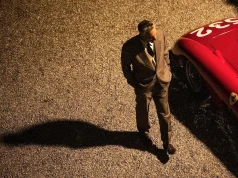
It takes an army to make a movie. Behind the writers, directors, producers and actors, hundreds of unseen hands toil endlessly to set the cinematic stage and deliver the illusion we call “movie magic.”
“You bring together what [is] real and what [is] cinematic, and you find your own truth,” costume designer Courtney Hoffman tells Boulder Weekly.
And that combination of what is real and what is cinematic forms the very core of Hoffman’s most recent work in The Hateful Eight — a snowy Western shot in Ultra Panavision 70 around Wilson Mesa in Telluride, Colorado.
Written and directed by Quentin Tarantino, The Hateful Eight is set a decade or so after the Civil War and is confined primarily to a trading post, Minnie’s Haberdashery, where two bounty hunters, a criminal, the local sheriff, a traveling hangman, a drifting cow puncher, a hired hand, a stagecoach driver and an old Confederate general ride out a blizzard.
Complicated by race relations, notions of justice and Tarantino’s hallmark for perverse gun violence, The Hateful Eight is a movie that confronts America’s violent and bloody past alongside its present. And true to Tarantino form, Hateful Eight relies heavily on cinematic history.
“As much as the objective is to make a good movie, it’s also to honor the medium,” Hoffman says.
A sentiment echoed by Hateful Eight’s set decorator, Rosemary Brandenburg.
“My dad was a history professor,” Brandenburg says. “He would scoff at these people because it wasn’t completely factual. Well, I don’t care. I love telling stories. Never let the facts in the way of a good story.”
Tarantino has never let the facts get in the way of a good story, making Brandenburg and Hoffman perfect collaborators to lend credence to the world of The Hateful Eight.
“I try to tell a story with every single object that I select or make or fabricate or rent or buy or whatever to stick in this environment,” Brandenburg explains. “It has to make sense for the whole story, and it has to make sense for the characters. And it has to provide a background.”
Brandenburg works hard to make sure every piece of décor provides “subliminal information” while conforming to the setting.
“How would this item have arrived in this frontier location?” Brandenburg asks herself. “It had to have arrived on somebody’s back or horse or in a covered wagon.”
A chair, a stove or a bear skin rug does not merely appear at Minnie’s Haberdashery, nor does it arrive intact or free of scuffs and scrapes.
“The textures and the aging and all of the history that this thing would have gone through, just to be there and to live in this environment,” Brandenburg continues. “With grease and grime and dirt and rats and mice and, you know, just nasty!”
With everything in its place, the décor becomes almost invisible and the world of the movie feels natural and lived in. It allows the eyes of the viewers to rest, which is Brandenburg’s goal.
“It’s almost like being the straight-man in a comedy,” Brandenburg says.
Not quite the same for Hoffman, whose costume designs provide information directly. Be it Major Marquis Warren’s (Samuel L. Jackson) Union cavalry outfit or a character switching hats in a key scene, each outfit clues the audience in.
“I definitely approach in research, after reading the script … and having those initial meetings with the director,” Hoffman says. “Now for Quentin, he really likes cinematic references. So you can show him all the photography and paintings in the world, and he’s always going to respond: ‘[I want] that jacket that’s in The Tall T [a 1957 Budd Boetticher Western] more than that jacket in that photo.’
“I ended up getting him on board with some pieces in the Autry Archives,” Hoffman continues. “John Ruth’s big buffalo coat was a piece that was actually from history.”
Much like Tarantino’s previous films — Inglourious Basterds and Django Unchained — this intersection of actual history and cinematic history is where these stories truly find their identity.
“I would look at old Westerns and then I would look at primary research,” Brandenburg adds. “In our movie there is an awful lot of action around a stove, so we would look at old stoves in movies. But maybe I didn’t really like their stoves. Maybe I could do better. I actually tried to do better than the old movies.”
Hoffman agrees, pointing out that she wanted to dress one of Hateful Eight’s bad guys in a black duster because of its tie to Once Upon a Time in the West.
“You can’t take it lightly when you have the ability to play with an iconic Western,” Hoffman says. “For us, it’s more like: how can I best serve this archetype — honoring all the archetypes that came before it — and create my own?”
Crafting an individual work while adhering to a historical precedent and fitting a director’s aesthetic isn’t an easy task, but in The Hateful Eight, Brandenburg and Hoffman pull it off in spades.














